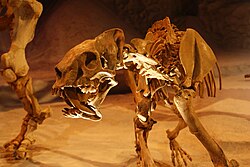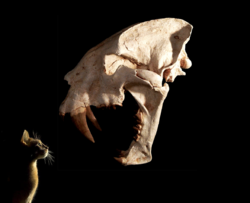Saber–toothed cat




The saber–toothed cats or sabretooth cats are some of the best known and most popular extinct animals. They are among the most impressive carnivores that ever have lived. These cats had long canines and jaws which opened wider than modern cats. This suggests a different style of killing from modern felines.[1]
The sabre-tooth style of life evolved at least five times amongst carnivorous mammals. This is one of the best-known examples of convergent evolution.
- Creodonts, were the earliest sabre-tooths known. They lived in the Eocene, and are in a different order from the Feliformia. Machaeroides and Apataelurus are examples.
- The Nimravids were a basal group in the Feliformia, lasting from the Eocene to the later Miocene epochs. Hoplophoneus is an example.
- The Barbourofelidae is another family of Feliforms which developed the sabre-tooth lifestyle. They flourished in the Miocene. They are probably more closely related to the felids than the Nimravids.
- Sparassodonts, such as Thylacosmilus, were a metatherian group of mammals. They used to be called "marsupial sabre-tooths", but they belong to a sister-group to the marsupials. Miocene to Pliocene.
- The Machairodontinae: a subfamily of the Felidae, lived from the Miocene to the Pleistocene (23 million years ago to 11,000 years ago). Includes the famous Smilodon.
- Nimravides, which is a member of the Felinae, and not one of the Nimravids.
The saber tooths were ambush predators, and probably lived in open forests. This would explain their widespread occurrence in the Miocene, when much of the land was covered with woodland. Apart from the canine teeth, their adaptations included strength in the forelimbs (more so than present-day large cats). Their robust (heavy, tough) bodies speak of strength rather than speed.[2]
An idea of how they killed is as follows. They hid in wait, and pounced. They hung on round the prey's neck, gripping and slashing the underside of the throat with their canine teeth. This would cause death by blood loss and loss of the air supply.[3][4]
The fact that their teeth vary is interesting. Some have larger teeth, some had smaller dagger-like teeth, some had smooth thick teeth, others had blade-like teeth, sometimes with serrated edges. Some had flanges on the lower jaw, most did not. Ewer remarks that this must show that there were variations in killing method, and in the type of prey, but we know little about this.[3]
There are none living today: they are extinct. The extinctions followed climate change, as the world cooled and grassland took over from woodland in the Pliocene and Pleistocene.
Saber–toothed Cat Media
A male Amphimachairodus giganteus was one of the largest machairodonts. It dwarfs its modern relative, the common house cat, Felis catus.
References
- ↑ The first person to suggest this was W.D. Matthew, a Canadian-born palaeontologist who was a curator of the American Museum of Natural History. Matthew W.D. 1910. The phylogeny of the Felidae. Bulletin of the American Museum of Natural History. 28, 289–316.
- ↑ Egi, Naoko 2001. Body mass estimates in extinct mammals from limb bone dimensions: the case of North American hyaenodontids. Palaeontology 44(3): 497–528.
- ↑ 3.0 3.1 Ewer R.F. 1954. Sabre-toothed tigers. New Biology. 17, 27–40
- ↑ Turner A. 1997. The big cats and their fossil relatives. New York: Columbia University Press, p124 and figure 4.24. ISBN 0-231-10229-1









